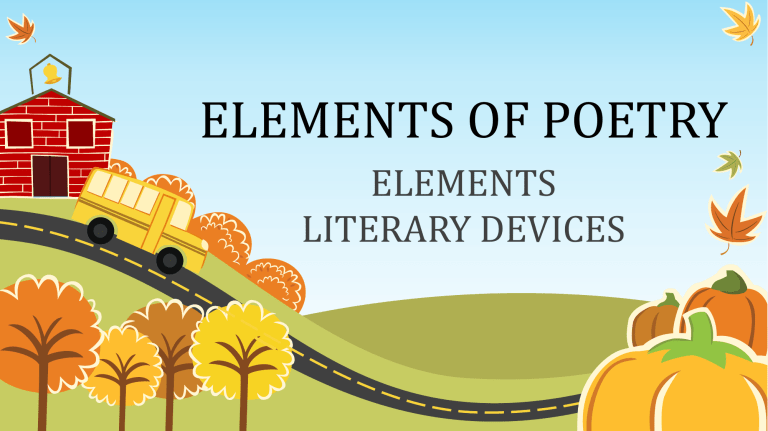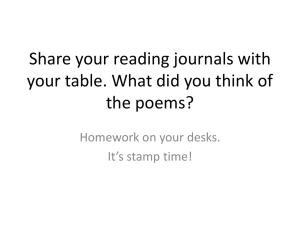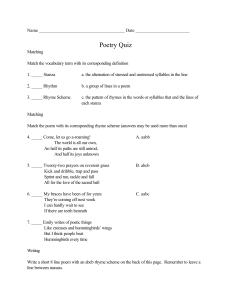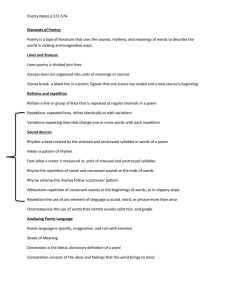Elements of Poetry: Lines, Stanza, Rhyme & Literary Devices
advertisement

ELEMENTS OF POETRY ELEMENTS LITERARY DEVICES POETRY is considered to be the counterpart of PROSE 3 S’ STRUCTURE POETRY STANZA & LINES SENSE COLORFUL LANGUAGE RHYME, RHYTHYM, METER SOUND PROSE SENTENCES & PARAGRAPH DIRECT MONOLOGUE 1. LINE • Counterpart of sentences in prose • May or may not have fixed number of syllables based on the type of poem 2. STANZA • Counterpart of paragraphs in prose • Group of lines • Has TYPES based on the number of lines that compose it TYPES OF STANZA • A. COUPLET - two lines • B. TERCET – three lines • C. TERZA RIMA – three stanzas of three lines • D. QUATRAIN – four lines • E. SESTET – six lines • F. OCTET – eight lines • G. CINQUAIN – five lines • H. SEPTET – seven lines 3. METER – measurement of the poem • TWO WAYS TO IDENTIFY THE METER OF THE POEM • 1. Looking at the syllables count of each line • 2. looking at the arrangement and number of STRESSED and UNSTRESSED syllables in each line. METER Unit/foot/Syllables Count Iambic Trimeter Three unit/feet(6 syllables) Iambic Tetrameter Four unit/feet (8 syllables) Iambic Pentameter Five unit/feet (10 syllables) Iambic Hexameter Six unit/feet (12 syllables) My Dim Heart by Maica Jill N. De Guzman Silent tears of pain, The Lord enters my dim heart Renewed strength and faith Si/lent/ tears /of/ pain/, The/ Lord/ en/ters/ my/ dim/ heart/ Re/newed/ strength/ and/ faith Types of METER 1. IAMBIC METER – metrical feet comprising one unstressed syllable followed by one stressed syllable (da-DUM) reCORD (v) 2. TROCHAIC METER – with one stressed followed by one unstressed syllable (DUM-da) RE-cord (n) 3. ANAPESTIC METER – with two unstressed followed by one stressed syllable (da-da-DUM) un-ders-TAND, in the SKY 4. DACTYLIC METER– one stressed followed by two unstressed syllables (DUM-da-da) HOPE-ful-ness, E-lephant, IN- the sun Types of METER 1. SPONDAIC METER – with two stressed syllables (DUMDUM. This meter creates a slow, heavy, and emphatic rhythm. 2. PYRRHIC METER – with two unstressed syllables (dada). It is not typically used in prevailing meter in a poem. It can be used within a line to create a softer or more subdued effect Types of METER 1. ACCENTUAL METER – each line has a fixed number of stresses, but varies in the total number of syllables. 2. SYLLABIC METER – each line has a fixed number of syllables, but varies in the total number stresses 3. ACCENTUAL-SYLLABIC METER – each line has the same number of stressed and non-stressed syllables in a fixed order. 4. FREE VERSE – lines have irregular patterns of stresses and syllables. 4. RHYME – pertains to the likeness of the sound • A poem without a RHYME is a BLANK VERSE. • TYPES OF RHYME • A. based on the position • B. based on the syllables count • C. based on the likeness of sound TYPES OF RHYME • A. END RHYME – the most common type of rhyme which can be found at the end of the lines. • B. INTERNAL/LEONINE RHYME – the rhyme which can be found in between two or more words in a single line. • C. MASCULINE RHYME – the rhyme consisting of a single stressed syllable as in “car” and “far”. TYPES OF RHYME • D. FEMININE RHYME – the rhyme consisting of a stressed syllable followed by n unstressed syllable, as in “mother” and “father” • E. PERFECT RHYME – the exact match of sounds in a rhyme, as in “ask” and “task” • F. SLANT RHYME – the imperfect rhyme, also called oblique rhyme or off rhyme, wherein the sounds are similar but not exactly the same, as in “port” and “heart.” 5. RHYTHM • pertains to the succession and alteration of rhymes 6. RHYME SCHEME/Rhythmic Pattern • This is done by assigning letters to each rhyme of the poem. I Wandered Lonely as a Cloud by William Wordsworth I wandered lonely as a Cloud The floats on high o’er vales and hills, When all at once I saw a crowd, A host, of golden daffodils; Beside the lake, beneath the trees, Fluttering and dancing in the breeze. 7. TONE • Is the overall impression a poet makes towards its readers. It is simply the emotions the writer in conveying through poetry. • It is highly affected by the writer’s choice of words – DICTION • e.g. Mad, Sad, Angry, Happy, Excited, Serious, Furious, etc. 8. THEME • Simply means the general idea of the topic of the poem/ a piece of writing. • COMMON THEME • Family, love, revenge, inspiration, friendship, overcoming fear, etc. 9. LESSON • It is simply the moral or the value inculcated in the words of poetry 9 ELEMENTS IN POETRY • LINE • STANZA • METER • RHYME • RHYME SCHEME • RHYTHYM • TONE • THEME • LESSON LITERARY TECHNIQUES AND DEVICES • DICTION – pertains to the writer’s choice of words • IMAGERY – use of descriptive language to paint a picture in the mind of the readers with the appeal of the FIVE SENSES • FIGURES OF SPEECH – are the expressions that deviate from literal meaning to add color to a language. HOW TO CREATE HYPER-POETRY HYPER-POETRY Is a form of poetry that incorporates multimedia elements and interactive features. It is define as a fusion of traditional poetry and technology. Poetry Hyper-poetry Poetry is literature that uses aesthetic and often rhythmic qualities of language Hyper poetry is digital poetry that is available on webpage and uses hyperlinks Created using a paper based Created using computer based medium medium Traditional poets handle their Involves lines of verse that appear language in such a way that it with links to footnotes, poetry evokes readers’ imagination, generators, sub-poem, or poetry creating visual and other imagery with images or movement in the readers’ mind. Example of Hyper-Poetry Title: Author: Add a Slide Title - 4 Add a Slide Title - 5





